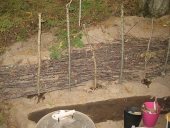








Brenda
Bloom where you are planted.
http://restfultrailsfoodforestgarden.blogspot.com/








Brenda
Bloom where you are planted.
http://restfultrailsfoodforestgarden.blogspot.com/








Brenda
Bloom where you are planted.
http://restfultrailsfoodforestgarden.blogspot.com/




Brenda
Bloom where you are planted.
http://restfultrailsfoodforestgarden.blogspot.com/





Idle dreamer




Brenda Groth wrote:
another really beautiful living fence is when you plant your trees and stake them on a 45 degree angle..either all one direction or crossing like an x..to form a fence..you can use a lot of tree types or shrubs to form these fences which will last forever..




Brenda
Bloom where you are planted.
http://restfultrailsfoodforestgarden.blogspot.com/








find religion! church
kiva! hyvä! iloinen! pikkumaatila
get stung! beehives
be hospitable! host-a-hive
be antisocial! facespace





Zone 5a (Canada)




Brenda
Bloom where you are planted.
http://restfultrailsfoodforestgarden.blogspot.com/

|
Can you really tell me that we aren't dealing with suspicious baked goods? And then there is this tiny ad:
Rocket Mass Heater Resources Wiki
https://permies.com/w/rmh-resources
|







